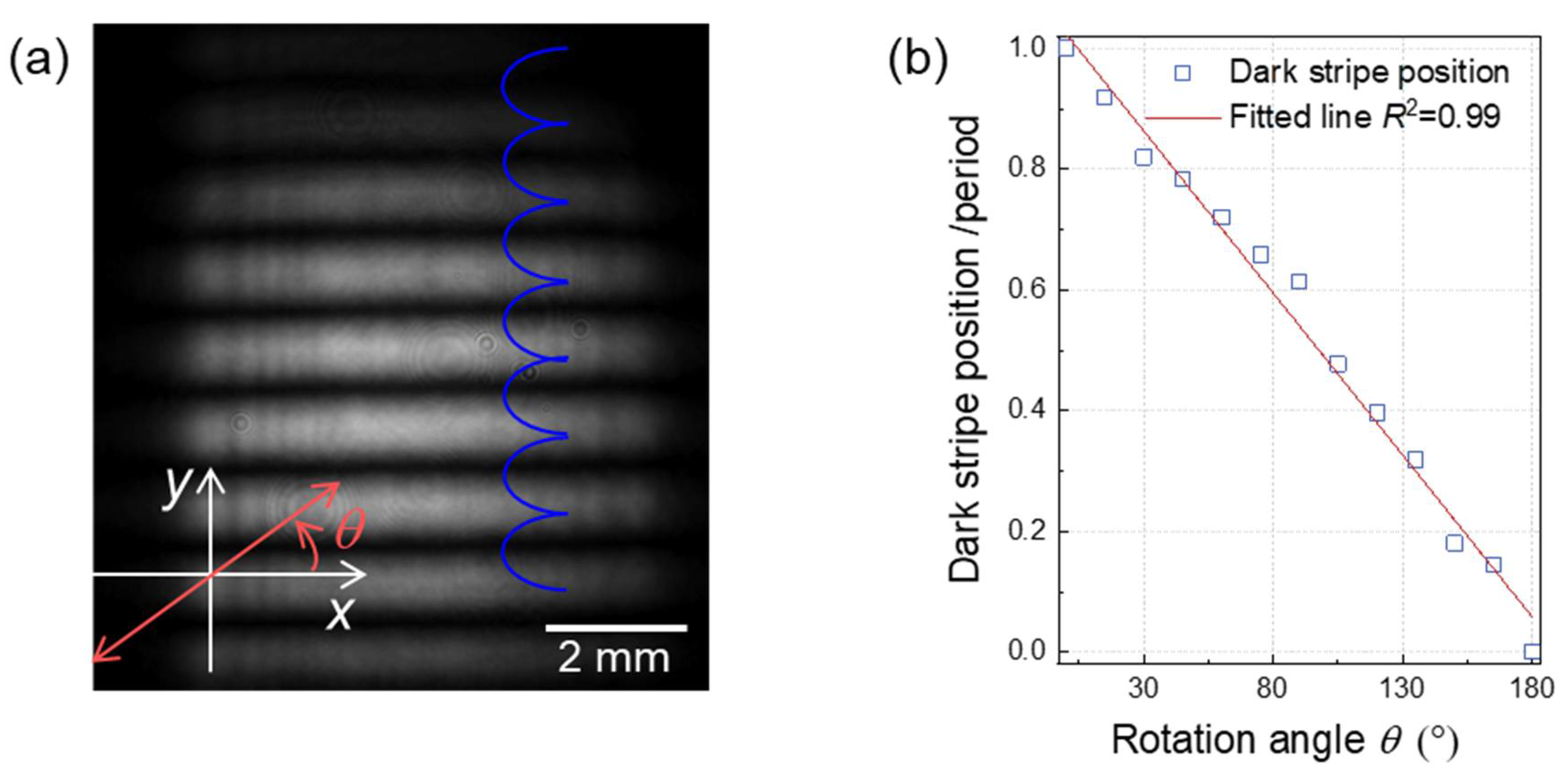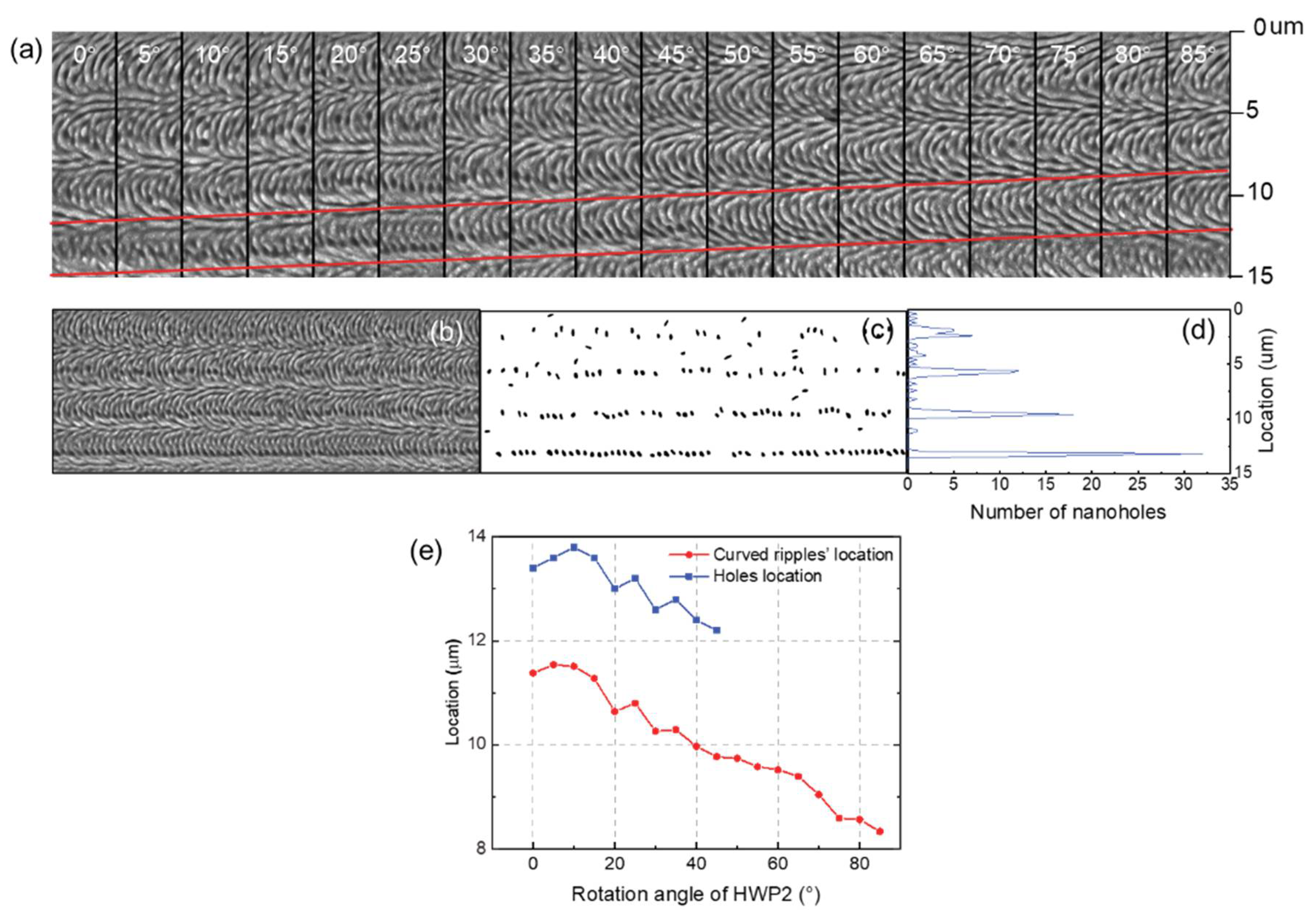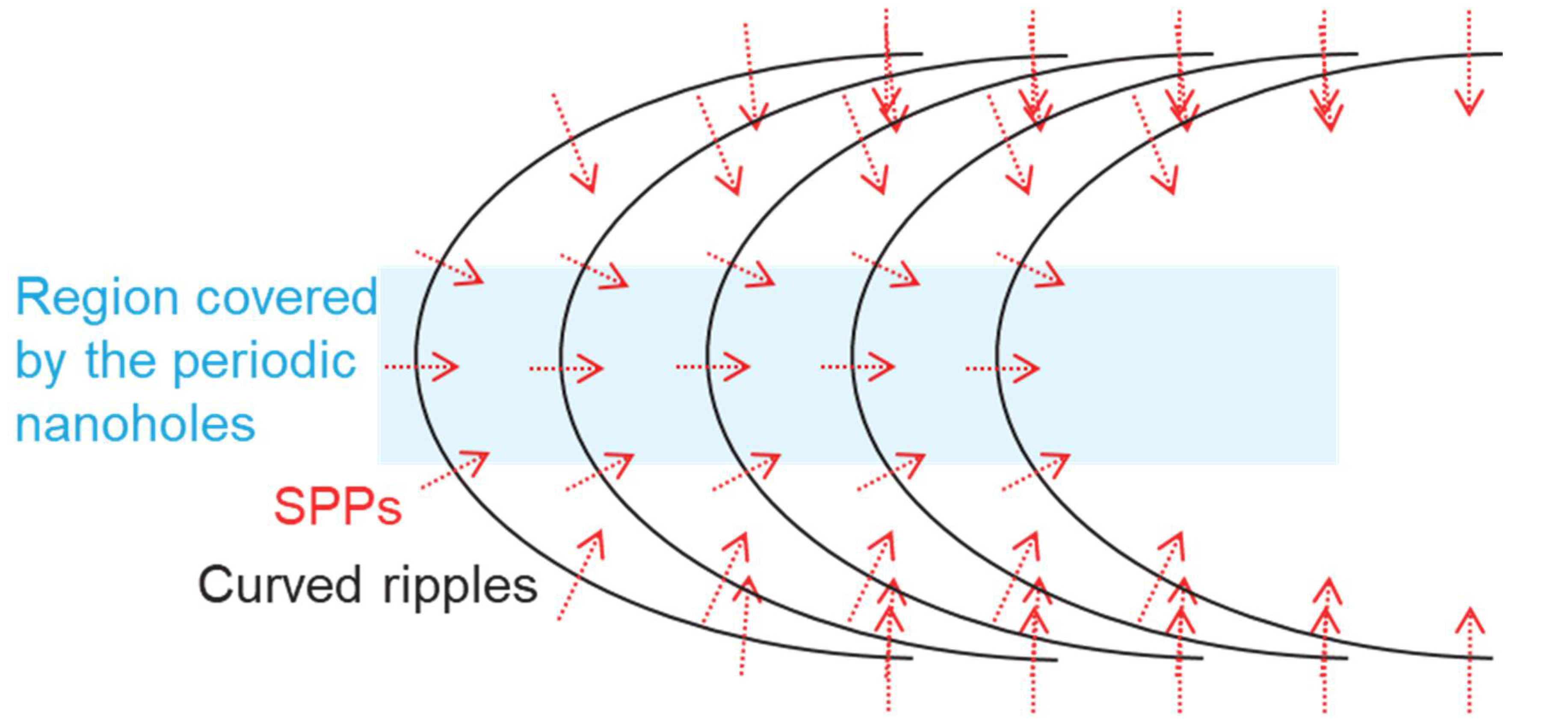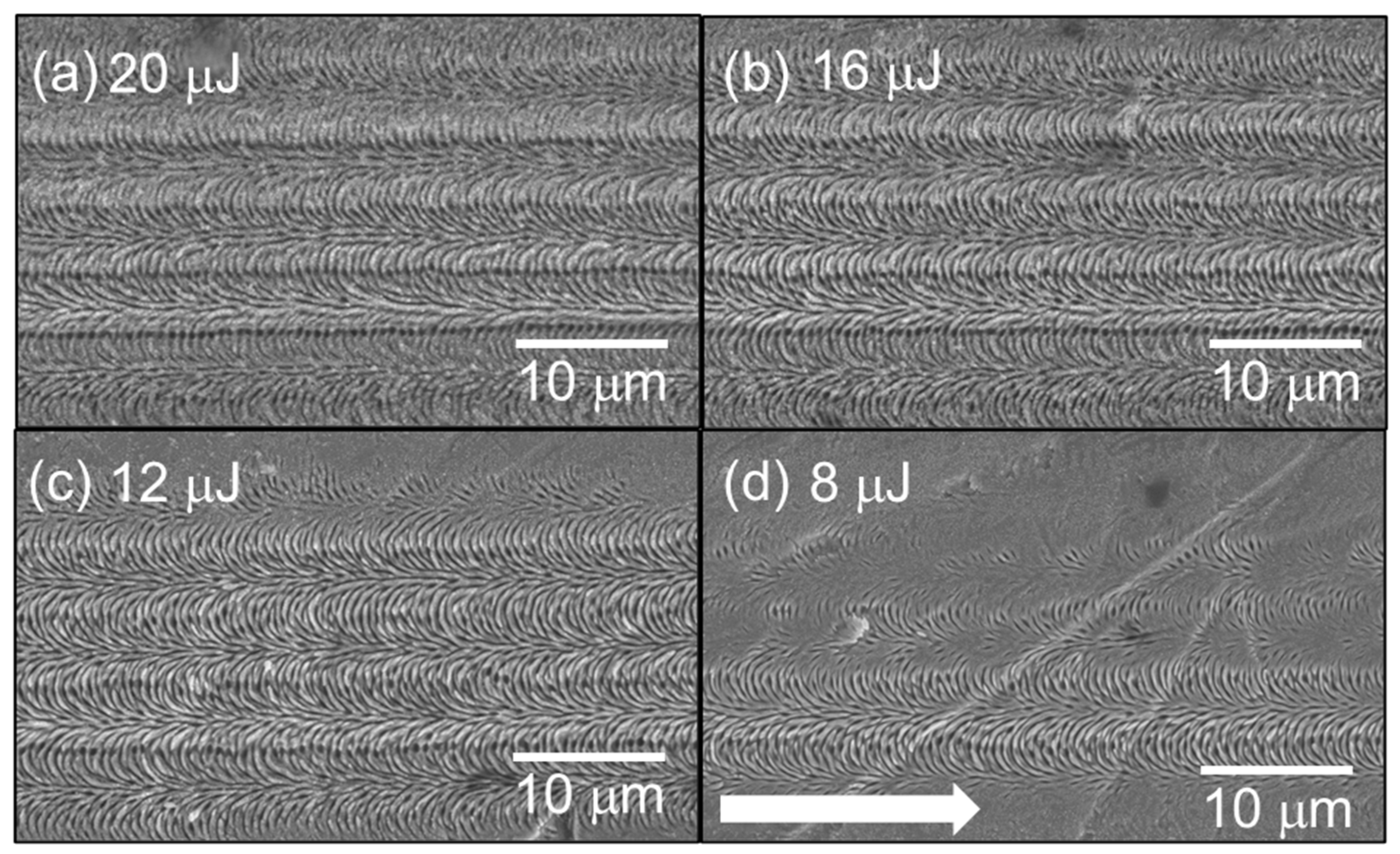Compound Structures of Periodic Holes and Curved Ripples Fabricated by the Interference between the Converging Surface Plasmon Polaritons and Femtosecond Laser
Abstract
:1. Introduction
2. Methods
3. Results and Discussion
4. Conclusions
Author Contributions
Funding
Data Availability Statement
Conflicts of Interest
References
- Yao, J.-W.; Zhang, C.-Y.; Liu, H.-Y.; Dai, Q.-F.; Wu, L.-J.; Lan, S.; Gopal, A.V.; Trofimov, V.A.; Lysak, T.M. High spatial frequency periodic structures induced on metal surface by femtosecond laser pulses. Opt. Express 2012, 20, 905–911. [Google Scholar] [CrossRef] [PubMed]
- Alamri, S.; Fraggelakis, F.; Kunze, T.; Krupop, B.; Mincuzzi, G.; Kling, R.; Lasagni, A.F. On the Interplay of DLIP and LIPSS Upon Ultra-Short Laser Pulse Irradiation. Materials 2019, 12, 1018. [Google Scholar] [CrossRef] [PubMed] [Green Version]
- Borowiec, A.; Haugen, H.K. Subwavelength ripple formation on the surfaces of compound semiconductors irradiated with femtosecond laser pulses. Appl. Phys. Lett. 2003, 82, 4462–4464. [Google Scholar] [CrossRef]
- Kafka, K.R.P.; Austin, D.R.; Li, H.; Yi, A.Y.; Cheng, J.; Chowdhury, E.A. Time-resolved measurement of single pulse femtosecond laser-induced periodic surface structure formation induced by a pre-fabricated surface groove. Opt. Express 2015, 23, 19432. [Google Scholar] [CrossRef] [PubMed]
- Hauschwitz, P.; Jochcová, D.; Jagdheesh, R.; Rostohar, D.; Brajer, J.; Kopeček, J.; Cimrman, M.; Smrž, M.; Mocek, T.; Lucianetti, A. Towards rapid large-scale LIPSS fabrication by 4-beam ps DLIP. Opt. Laser Technol. 2021, 133, 106532. [Google Scholar] [CrossRef]
- Ali, N.; Bashir, S.; Umm-i-Kalsoom; Shahid Rafique, M.; Begum, N.; Husinsky, W.; Ajami, A.; Natahala, C.S.R. Femtosecond laser induced nanostructuring of zirconium in liquid confined environment. Chin. Phys. B 2017, 26, 015204. [Google Scholar] [CrossRef]
- Min-Jian, Z.; Guang-Lei, G.; Jun-Yi, Y.; Ning-Hua, M.; Guo, Y.; Xiao-Dong, G.; Ru-Xin, L.; Hong-Liang, M. Femtosecond pulse laser-induced self-organized nanostructures on the surface of ZnO crystal. Chin. Phys. B 2008, 17, 1223–1226. [Google Scholar] [CrossRef]
- Vorobyev, A.Y.; Guo, C. Spectral and polarization responses of femtosecond laser-induced periodic surface structures on metals. J. Appl. Phys. 2008, 103, 043513. [Google Scholar] [CrossRef]
- Shukla, P.; Waugh, D.G.; Lawrence, J.; Vilar, R. Laser Surface Structuring of Ceramics, Metals and Polymers for Biomedical Applications. In Laser Surface Modification of Biomaterials; Elsevier: Amsterdam, The Netherlands, 2016; pp. 281–299. ISBN 9780081009420. [Google Scholar]
- Dusser, B.; Sagan, Z.; Soder, H.; Faure, N.; Colombier, J.P.; Jourlin, M.; Audouard, E. Controlled nanostructrures formation by ultra fast laser pulses for color marking. Opt. Express 2010, 18, 2913–2924. [Google Scholar] [CrossRef] [Green Version]
- Vorobyev, A.Y.; Guo, C. Antireflection effect of femtosecond laser-induced periodic surface structures on silicon. Opt. Express 2011, 19, A1031–A1036. [Google Scholar] [CrossRef]
- Khan, S.A.; Boltaev, G.S.; Iqbal, M.; Kim, V.; Ganeev, R.A.; Alnaser, A.S. Ultrafast fiber laser-induced fabrication of superhydrophobic and self-cleaning metal surfaces. Appl. Surf. Sci. 2021, 542, 148560. [Google Scholar] [CrossRef]
- Žemaitis, A.; Mimidis, A.; Papadopoulos, A.; Gečys, P.; Račiukaitis, G.; Stratakis, E.; Gedvilas, M. Controlling the wettability of stainless steel from highly-hydrophilic to super-hydrophobic by femtosecond laser-induced ripples and nanospikes. RSC Adv. 2020, 10, 37956–37961. [Google Scholar] [CrossRef]
- Jagdheesh, R.; BicisTová, R.; Brajer, J.; Mocek, T. Laser-induced superhydrophobic and oleophobic surface structures on float glass. Lasers Eng. 2021, 50, 289–298. [Google Scholar]
- Ivanova, E.P.; Hasan, J.; Webb, H.K.; Gervinskas, G.; Juodkazis, S.; Truong, V.K.; Wu, A.H.F.; Lamb, R.N.; Baulin, V.A.; Watson, G.S.; et al. Bactericidal activity of black silicon. Nat. Commun. 2013, 4, 2838. [Google Scholar] [CrossRef]
- Richter, A.M.; Buchberger, G.; Stifter, D.; Duchoslav, J.; Hertwig, A.; Bonse, J.; Heitz, J.; Schwibbert, K. Spatial Period of Laser-Induced Surface Nanoripples on PET Determines Escherichia coli Repellence. Nanomaterials 2021, 11, 3000. [Google Scholar] [CrossRef]
- Buividas, R.; Mikutis, M.; Juodkazis, S. Surface and bulk structuring of materials by ripples with long and short laser pulses: Recent advances. Prog. Quantum Electron. 2014, 38, 119–156. [Google Scholar] [CrossRef]
- Huang, M.; Zhao, F.; Cheng, Y.; Xu, N.; Xu, Z. Origin of Laser-Induced Near-Subwavelength Ripples: Interference between Surface Plasmons and Incident Laser. ACS Nano 2009, 3, 4062–4070. [Google Scholar] [CrossRef]
- Sakabe, S.; Hashida, M.; Tokita, S.; Namba, S.; Okamuro, K. Mechanism for self-formation of periodic grating structures on a metal surface by a femtosecond laser pulse. Phys. Rev. B 2009, 79, 033409. [Google Scholar] [CrossRef] [Green Version]
- Shen, W.C. Fabrication of Novel Structures on Silicon with Femtosecond Laser Pulses. J. Laser Micro/Nanoeng. 2010, 5, 229–232. [Google Scholar] [CrossRef]
- Hnatovsky, C.; Shvedov, V.; Krolikowski, W.; Rode, A. Revealing Local Field Structure of Focused Ultrashort Pulses. Phys. Rev. Lett. 2011, 106, 123901. [Google Scholar] [CrossRef]
- Lou, K.; Qian, S.-X.; Wang, X.-L.; Li, Y.; Gu, B.; Tu, C.; Wang, H.-T. Two-dimensional microstructures induced by femtosecond vector light fields on silicon. Opt. Express 2012, 20, 120–127. [Google Scholar] [CrossRef] [PubMed]
- Anoop, K.K.; Rubano, A.; Fittipaldi, R.; Wang, X.; Paparo, D.; Vecchione, A.; Marrucci, L.; Bruzzese, R.; Amoruso, S. Femtosecond laser surface structuring of silicon using optical vortex beams generated by a q-plate. Appl. Phys. Lett. 2014, 104, 241604. [Google Scholar] [CrossRef] [Green Version]
- Tsibidis, G.D.; Skoulas, E.; Stratakis, E. Ripple formation on nickel irradiated with radially polarized femtosecond beams. Opt. Lett. 2015, 40, 5172–5175. [Google Scholar] [CrossRef] [PubMed] [Green Version]
- JJ Nivas, J.; He, S.; Rubano, A.; Vecchione, A.; Paparo, D.; Marrucci, L.; Bruzzese, R.; Amoruso, S. Direct Femtosecond Laser Surface Structuring with Optical Vortex Beams Generated by a q-plate. Sci. Rep. 2015, 5, 17929. [Google Scholar] [CrossRef] [Green Version]
- Skoulas, E.; Manousaki, A.; Fotakis, C.; Stratakis, E. Biomimetic surface structuring using cylindrical vector femtosecond laser beams. Sci. Rep. 2017, 7, 45114. [Google Scholar] [CrossRef] [Green Version]
- Cheng, H.; Li, P.; Liu, S.; Chen, P.; Han, L.; Zhang, Y.; Hu, W.; Zhao, J. Vortex-controlled morphology conversion of microstructures on silicon induced by femtosecond vector vortex beams. Appl. Phys. Lett. 2017, 111, 141901. [Google Scholar] [CrossRef]
- JJ Nivas, J.; Allahyari, E.; Cardano, F.; Rubano, A.; Fittipaldi, R.; Vecchione, A.; Paparo, D.; Marrucci, L.; Bruzzese, R.; Amoruso, S. Vector vortex beams generated by q-plates as a versatile route to direct fs laser surface structuring. Appl. Surf. Sci. 2019, 471, 1028–1033. [Google Scholar] [CrossRef]
- Cai, M.-Q.; Li, P.-P.; Feng, D.; Pan, Y.; Qian, S.-X.; Li, Y.; Tu, C.; Wang, H.-T. Microstructures fabricated by dynamically controlled femtosecond patterned vector optical fields. Opt. Lett. 2016, 41, 1474. [Google Scholar] [CrossRef]
- Tingyuan, W.; Weiwei, L.; Nan, Z.; Zhiqiang, Y.; Lu, F.; Hongshuang, L.; Langfeng, Z. Investigation of Fabricating Periodic Curved Ripple Structures on Tungsten Surface by Femtosecond Non-Cylindrical Vector Beam. Chin. J. Lasers 2019, 5, 7. [Google Scholar]
- Schindelin, J.; Rueden, C.T.; Hiner, M.C.; Eliceiri, K.W. The ImageJ ecosystem: An open platform for biomedical image analysis. Mol. Reprod. Dev. 2015, 82, 518–529. [Google Scholar] [CrossRef] [Green Version]
- Wang, S.; Zhao, C.; Li, X. Dynamical manipulation of surface plasmon polaritons. Appl. Sci. 2019, 9, 3297. [Google Scholar] [CrossRef] [Green Version]






Publisher’s Note: MDPI stays neutral with regard to jurisdictional claims in published maps and institutional affiliations. |
© 2022 by the authors. Licensee MDPI, Basel, Switzerland. This article is an open access article distributed under the terms and conditions of the Creative Commons Attribution (CC BY) license (https://creativecommons.org/licenses/by/4.0/).
Share and Cite
Wang, T.; Lin, L.; Zhang, N. Compound Structures of Periodic Holes and Curved Ripples Fabricated by the Interference between the Converging Surface Plasmon Polaritons and Femtosecond Laser. Appl. Sci. 2022, 12, 2543. https://doi.org/10.3390/app12052543
Wang T, Lin L, Zhang N. Compound Structures of Periodic Holes and Curved Ripples Fabricated by the Interference between the Converging Surface Plasmon Polaritons and Femtosecond Laser. Applied Sciences. 2022; 12(5):2543. https://doi.org/10.3390/app12052543
Chicago/Turabian StyleWang, Tingyuan, Lie Lin, and Nan Zhang. 2022. "Compound Structures of Periodic Holes and Curved Ripples Fabricated by the Interference between the Converging Surface Plasmon Polaritons and Femtosecond Laser" Applied Sciences 12, no. 5: 2543. https://doi.org/10.3390/app12052543
APA StyleWang, T., Lin, L., & Zhang, N. (2022). Compound Structures of Periodic Holes and Curved Ripples Fabricated by the Interference between the Converging Surface Plasmon Polaritons and Femtosecond Laser. Applied Sciences, 12(5), 2543. https://doi.org/10.3390/app12052543




